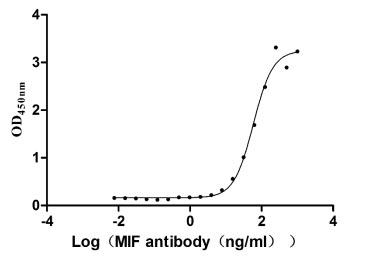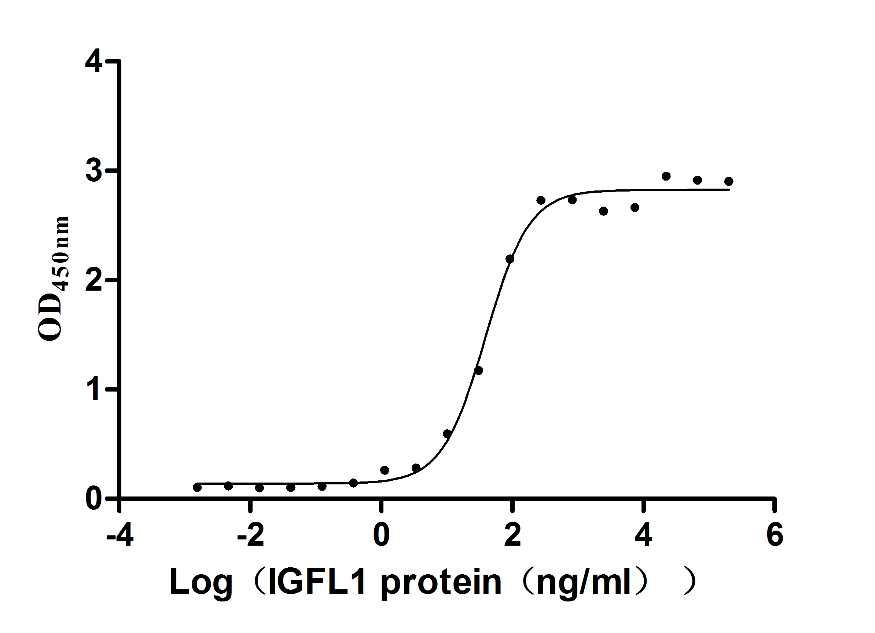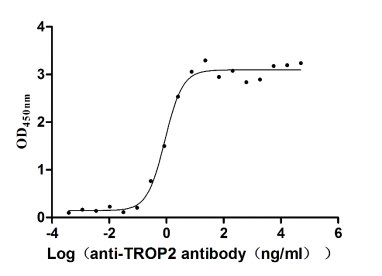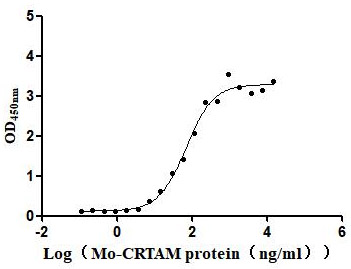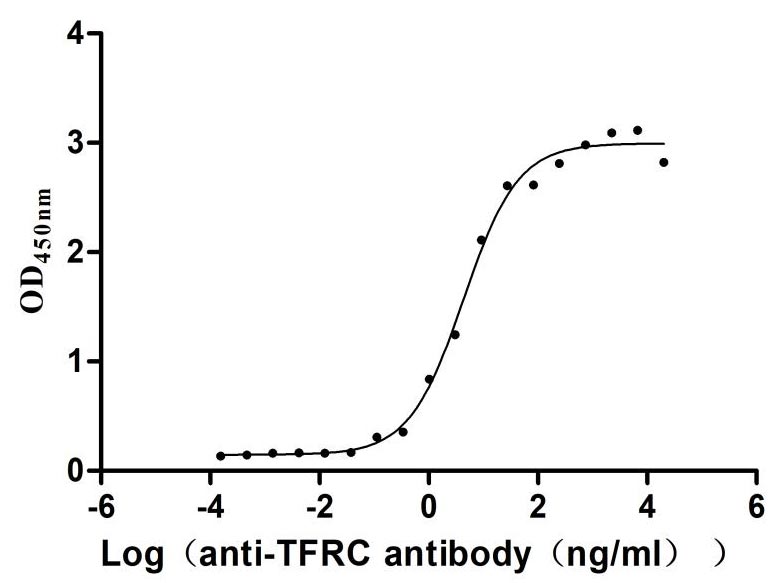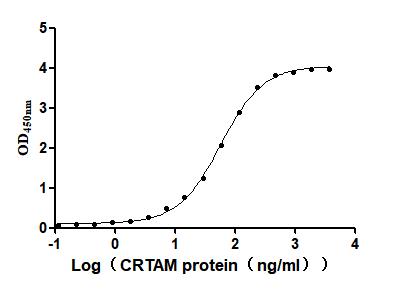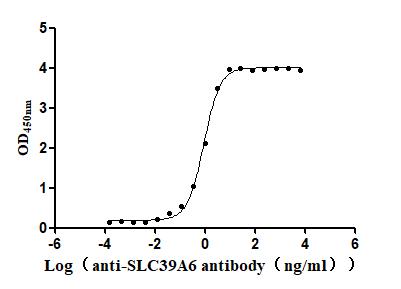Recombinant Mouse Protein kinase C iota type (Prkci)
-
中文名称:小鼠Prkci重组蛋白
-
货号:CSB-YP714008MO
-
规格:
-
来源:Yeast
-
其他:
-
中文名称:小鼠Prkci重组蛋白
-
货号:CSB-EP714008MO
-
规格:
-
来源:E.coli
-
其他:
-
中文名称:小鼠Prkci重组蛋白
-
货号:CSB-EP714008MO-B
-
规格:
-
来源:E.coli
-
共轭:Avi-tag Biotinylated
E. coli biotin ligase (BirA) is highly specific in covalently attaching biotin to the 15 amino acid AviTag peptide. This recombinant protein was biotinylated in vivo by AviTag-BirA technology, which method is BriA catalyzes amide linkage between the biotin and the specific lysine of the AviTag.
-
其他:
-
中文名称:小鼠Prkci重组蛋白
-
货号:CSB-BP714008MO
-
规格:
-
来源:Baculovirus
-
其他:
-
中文名称:小鼠Prkci重组蛋白
-
货号:CSB-MP714008MO
-
规格:
-
来源:Mammalian cell
-
其他:
产品详情
-
纯度:>85% (SDS-PAGE)
-
基因名:
-
Uniprot No.:
-
别名:Prkci; PkclProtein kinase C iota type; EC 2.7.11.13; Atypical protein kinase C-lambda/iota; aPKC-lambda/iota; nPKC-iota
-
种属:Mus musculus (Mouse)
-
蛋白长度:Full Length of Mature Protein
-
表达区域:2-595
-
氨基酸序列PTQRDSSTM SHTVACGGGG DHSHQVRVKA YYRGDIMITH FEPSISFEGL CSEVRDMCSF DNEQPFTMKW IDEEGDPCTV SSQLELEEAF RLYELNKDSE LLIHVFPCVP ERPGMPCPGE DKSIYRRGAR RWRKLYCANG HTFQAKRFNR RAHCAICTDR IWGLGRQGYK CINCKLLVHK KCHKLVTIEC GRHSLPPEPM MPMDQTMHPD HTQTVIPYNP SSHESLDQVG EEKEAMNTRE SGKASSSLGL QDFDLLRVIG RGSYAKVLLV RLKKTDRIYA MKVVKKELVN DDEDIDWVQT EKHVFEQASN HPFLVGLHSC FQTESRLFFV IEYVNGGDLM FHMQRQRKLP EEHARFYSAE ISLALNYLHE RGIIYRDLKL DNVLLDSEGH IKLTDYGMCK EGLRPGDTTS TFCGTPNYIA PEILRGEDYG FSVDWWALGV LMFEMMAGRS PFDIVGSSDN PDQNTEDYLF QVILEKQIRI PRSLSVKAAS VLKSFLNKDP KERLGCHPQT GFADIQGHPF FRNVDWDMME QKQVVPPFKP NISGEFGLDN FDSQFTNEPV QLTPDDDDIV RKIDQSEFEG FEYINPLLMS AEECV
-
蛋白标签:Tag type will be determined during the manufacturing process.
The tag type will be determined during production process. If you have specified tag type, please tell us and we will develop the specified tag preferentially. -
产品提供形式:Lyophilized powder
Note: We will preferentially ship the format that we have in stock, however, if you have any special requirement for the format, please remark your requirement when placing the order, we will prepare according to your demand. -
复溶:We recommend that this vial be briefly centrifuged prior to opening to bring the contents to the bottom. Please reconstitute protein in deionized sterile water to a concentration of 0.1-1.0 mg/mL.We recommend to add 5-50% of glycerol (final concentration) and aliquot for long-term storage at -20℃/-80℃. Our default final concentration of glycerol is 50%. Customers could use it as reference.
-
储存条件:Store at -20°C/-80°C upon receipt, aliquoting is necessary for mutiple use. Avoid repeated freeze-thaw cycles.
-
保质期:The shelf life is related to many factors, storage state, buffer ingredients, storage temperature and the stability of the protein itself.
Generally, the shelf life of liquid form is 6 months at -20°C/-80°C. The shelf life of lyophilized form is 12 months at -20°C/-80°C. -
货期:Delivery time may differ from different purchasing way or location, please kindly consult your local distributors for specific delivery time.Note: All of our proteins are default shipped with normal blue ice packs, if you request to ship with dry ice, please communicate with us in advance and extra fees will be charged.
-
注意事项:Repeated freezing and thawing is not recommended. Store working aliquots at 4°C for up to one week.
-
Datasheet :Please contact us to get it.
靶点详情
-
功能:Calcium- and diacylglycerol-independent serine/ threonine-protein kinase that plays a general protective role against apoptotic stimuli, is involved in NF-kappa-B activation, cell survival, differentiation and polarity, and contributes to the regulation of microtubule dynamics in the early secretory pathway. Is necessary for BCR-ABL oncogene-mediated resistance to apoptotic drug in leukemia cells, protecting leukemia cells against drug-induced apoptosis. In cultured neurons, prevents amyloid beta protein-induced apoptosis by interrupting cell death process at a very early step. In glioblastoma cells, may function downstream of phosphatidylinositol 3-kinase (PI3K) and PDPK1 in the promotion of cell survival by phosphorylating and inhibiting the pro-apoptotic factor BAD. Can form a protein complex in non-small cell lung cancer (NSCLC) cells with PARD6A and ECT2 and regulate ECT2 oncogenic activity by phosphorylation, which in turn promotes transformed growth and invasion. In response to nerve growth factor (NGF), acts downstream of SRC to phosphorylate and activate IRAK1, allowing the subsequent activation of NF-kappa-B and neuronal cell survival. Functions in the organization of the apical domain in epithelial cells by phosphorylating EZR. This step is crucial for activation and normal distribution of EZR at the early stages of intestinal epithelial cell differentiation. Forms a protein complex with LLGL1 and PARD6B independently of PARD3 to regulate epithelial cell polarity. Plays a role in microtubule dynamics in the early secretory pathway through interaction with RAB2A and GAPDH and recruitment to vesicular tubular clusters (VTCs). In human coronary artery endothelial cells (HCAEC), is activated by saturated fatty acids and mediates lipid-induced apoptosis. Downstream of PI3K is required for insulin-stimulated glucose transport. Activates RAB4A and promotes its association with KIF3A which is required for the insulin-induced SLC2A4/GLUT4 translocation in adipocytes. Is essential in early embryogenesis and development of differentiating photoreceptors by playing a role in the establishment of epithelial and neuronal polarity. Involved in early synaptic long term potentiation phase in CA1 hippocampal cells and short term memory formation.
-
基因功能参考文献:
- these findings suggest that miR-29c is a negative regulator of axonal growth of dorsal root ganglia neurons by targeting PRKCI under hyperglycemia. PMID: 28070856
- PKClambda/iota emerges as a critical regulator of Th17 differentiation and allergic airway hyperresponsiveness. PMID: 29305916
- This study demonstrated hat under physiological conditions, PKCiota/lambda is essential for hippocampal early-LTP and long-term memory. PMID: 28383692
- the aPKC-CBP pathway is a homeostatic compensatory mechanism that modulates hippocampal neurogenesis and memory in an age-dependent manner in response to reduced CREB activity. PMID: 27618724
- he oncogenic activity of PRKCI relates in part to the up-regulation of TNFalpha to promote an immune-suppressive tumor microenvironment characterized by an abundance of myeloid-derived suppressor cells and inhibition of cytotoxic T-cell infiltration PMID: 28698296
- Selective deletion of the aPKC isoform Pkc-lambda in proopiomelanocortin (POMC) neurons disrupts leptin action, reduces melanocortin content in the paraventricular nucleus, and markedly increases susceptibility to obesity, glucose intolerance, and insulin resistance specifically in HFD-fed male mice. PMID: 28073831
- results identify a novel role of PHLPP in regulating aPKC and cell polarity. PMID: 27760826
- Prkci and its downstream partners direct polarized cell division of luminal myocardial cells to drive trabeculation in the nascent heart. PMID: 26876178
- Prkci regulates expansion of various stem cells via Notch-dependent pathway. PMID: 26527382
- PKClambda/iota could be a crucial regulator of mitochondrial function and energy metabolism in stem cells and other cellular contexts PMID: 25142417
- Asymmetric division and CD8+ T lymphocyte fate specification is regulated by protein kinase Czeta and protein kinase Clambda. PMID: 25617472
- adenoviral-mediated supplementation of hepatic PKC-lambda induced a diabetic state in heterozygous PKC-lambda knockout mice. PMID: 24877563
- Data indicate that pseudosubstrate arginine residues are key regulators of atypical protein kinase C-lambda and atypical protein kinase C-zeta. PMID: 25035426
- Loss of aPKClambda in differentiated neurons disrupts the polarity complex but does not induce obvious neuronal loss or disorientation in mouse brains. PMID: 24391875
- Down-regulation of aPKC, involved in cell polarity, decreases the number of apical nuclei and doubles the number of asymmetric divisions. PMID: 24855000
- Data demonstrate that PKCiota is required for a tumor-initiating cell phenotype in ovarian cancer. PMID: 24174471
- PKClambda/iota was identified as an important factor for actin cytoskeletal regulation in podocytes and Def-6 as a specific downstream target of PKClambda/iota that regulates the activity of small GTPases and subsequently the actin cytoskeleton of podocytes. PMID: 24096077
- Phosphatidylinositol-3,4,5-triphosphate but not phosphatidylinositol-4,5-biphosphate plays an important role in GLUT4 upregulation and glucose metabolism mediated by AKT/PKCzeta/lambda phosphorylation. PMID: 23749168
- FGF21 inhibits hepatic glucose production by the PI3K-dependent activation of protein kinase c iota. PMID: 23305840
- aPKClambda is critical for PDGF-induced actin cytoskeletal reorganization and cell migration. PMID: 24092753
- PKCiota is crucial for mouse embryogenesis but is dispensable for the establishment of polarity and tight junction formation. PMID: 23690951
- aPKC is a central player in the segregation of epiblast and primitive endoderm progenitors in the mouse blastocyst. PMID: 24067354
- Defective aPKC signaling results in a dramatically simplified glomerular architecture, causing severe proteinuria and perinatal death. PMID: 23334392
- results demonstrate that aPKC-iota/lambda is critical for hedgehog-dependent processes and implicates aPKC-iota/lambda as a new, tumour-selective therapeutic target for the treatment of smoothened-inhibitor-resistant cancers PMID: 23446420
- protein kinase C iota as a therapeutic target in alveolar rhabdomyosarcoma PMID: 22349825
- PKCiota is an early marker of pancreatic neoplasia and PKCiota is a potential downstream target of K-ras(G12D) in pancreatic ductal metaplasia in vivo. PMID: 22359542
- Hydrogen sulfide and L-cysteine increase phosphatidylinositol 3,4,5-trisphosphate and glucose utilization by inhibiting PTEN protein and activating PI3K,AKT, PKCzeta/lambda in 3T3l1 adipocytes. PMID: 21953448
- Data show that deletion of aPKCzeta and aPKClambda have normal hematopoiesis, including normal HSC self-renewal, engraftment, differentiation, and interaction with the bone marrow microenvironment. PMID: 21653884
- PKCiota and GSK-3beta are downstream effectors of Cdc42 during vascular morphogenesis. PMID: 21659643
- These findings demonstrate a surprising role of aPKC-Aurora A-NDEL1 pathway in microtubule remodelling during neurite extension.[aPKC] PMID: 19668197
- aPKClambda has a role in context dependent allocation of cell lineages in preimplantation mouse embryos PMID: 19768116
- Data show that mice that lack protein kinase c lambda in the liver exhibit increased insulin sensitivity as well as a decreased triglyceride content and reduced expression of the sterol regulatory element-binding protein-1c (SREBP-1c) gene in the liver. PMID: 12975478
- insulin activates PKC-lambda and glucose transport in embryonic stem cells PMID: 14615604
- PKCzeta/lambda can serve as a convergent downstream target for both the PI 3-kinase and TC10 signaling pathways. PMID: 14734537
- Data demonstrate that protein kinase C (PKC) iota is required for oncogenic Ras- and carcinogen-mediated colon carcinogenesis in vivo and define a procarcinogenic signaling axis consisting of Ras, PKCiota, and Rac1. PMID: 15024028
- insulin secretion in response to high concentrations of glucose was impaired, whereas the basal rate of insulin release was increased, in islets isolated from betaPKClambda(-/-) mice PMID: 15630453
- The natural spatial allocation of blastomere progeny can be over-ridden by downregulation of aPKC, leading to a deceased tendency for them to remain outside and so develop into trophectoderm. PMID: 15657073
- Expression of atypical protein kinase C lambda in differentiating photoreceptors is required for total retinal lamination. PMID: 16267237
- Inactivation of aPKClambda results in the loss of adherens junctions in neuroepithelial cells without affecting neurogenesis in the neocortex. PMID: 16571631
- atypical PKCs are required for insulin-stimulated glucose transport in myocytes and adipocytes PMID: 16644736
- used isoform-specific riboprobes and antibodies to define the characteristic expression profile of each aPKC isoform during embryogenesis PMID: 16931174
- Novel mechanism by which a ceramide-induced, apicolateral polarity complex with PKCzeta/lambda regulates primitive ectoderm cell polarity and morphogenesis. PMID: 17105725
- The levels of p-PKC lambda was significantly reduced in GHRKO vs normal mice with no diet effects. PMID: 17301033
- It is shown that activation of PKCeta by PDK1 is driven by atypical PKClambda. PMID: 18042254
- Neph1-Nephrin proteins bind the Par3-Par6-atypical protein kinase C (aPKC) complex to regulate podocyte cell polarity PMID: 18562307
- Atypical protein kinase C iota expression has a role in aurothiomalate sensitivity in lung cancer cells PMID: 18632643
- The aPKC-PAR3 complex associates with the nephrin-podocin complex in podocytes through direct interaction between PAR3 and nephrin, and the kinase activity of aPKC is required for the appropriate distribution of nephrin and podocin in podocytes. PMID: 19142224
- PKC lambda/iota emerges as a critical regulator of Th 2 activation. PMID: 19144923
- aPKC signaling is fundamental to glomerular maintenance and development and loss in podocytes causes nephrotic syndrome in mice. PMID: 19279126
- Basal or elevated aPKC activity is required for the ability of Src-transformed cells to degrade and invade the extracellular matrix. PMID: 19492416
显示更多
收起更多
-
亚细胞定位:Cytoplasm. Membrane. Endosome. Nucleus.
-
蛋白家族:Protein kinase superfamily, AGC Ser/Thr protein kinase family, PKC subfamily
-
数据库链接:
Most popular with customers
-
Recombinant Human Macrophage migration inhibitory factor (MIF) (Active)
Express system: Mammalian cell
Species: Homo sapiens (Human)
-
Recombinant Human Tumor necrosis factor ligand superfamily member 9 (TNFSF9), partial (Active)
Express system: Mammalian cell
Species: Homo sapiens (Human)
-
Recombinant Human IGF-like family receptor 1 (IGFLR1), partial (Active)
Express system: Mammalian cell
Species: Homo sapiens (Human)
-
Recombinant Human Tumor-associated calcium signal transducer 2 (TACSTD2), partial (Active)
Express system: Mammalian cell
Species: Homo sapiens (Human)
-
Recombinant Mouse Cell adhesion molecule 1 (Cadm1), partial (Active)
Express system: Mammalian cell
Species: Mus musculus (Mouse)
-
Recombinant Human Transferrin receptor protein 1 (TFRC), partial (Active)
Express system: Mammalian cell
Species: Homo sapiens (Human)
-
Recombinant Mouse Cytotoxic and regulatory T-cell molecule (Crtam), partial (Active)
Express system: Mammalian cell
Species: Mus musculus (Mouse)
-
Recombinant Macaca fascicularis Zinc transporter ZIP6 isoform X1(SLC39A6),partial (Active)
Express system: Baculovirus
Species: Macaca fascicularis (Crab-eating macaque) (Cynomolgus monkey)


